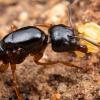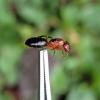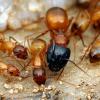All very good points. In my opinion, a diet of fresh insects is more specialized than seeds, seeing as chia seeds and many other types can be found at most grocery stores. I guess my criteria were what species requires the least amount of maintenance, and out of my (admittedly, limited) collection P. occidentalis are the ants that I worry least about, because as long as they have a seed store they're eating well.I absolutely disagree that Pogonomyrmex occidentalis are the perfect ant for captivity. Not even close.
They have a sting, and not one to scoff at. They're also very aggressive. For an inexperienced keeper stings may be commonplace when cleaning outworlds or moving colonies to new formicaria.
They have a specialized diet. Seeds are one of the easier specialized diets to support, but it's still something that needs to be considered by the keeper.
They have extremely small social stomachs, meaning that feedings need to be consistent and frequent. The only way this is partially negated is with a healthy seed cache in the nest, and even that's not perfect.
Being from a primarily temperate climate, they may require a period of diapause that may be difficult for inexperienced keepers. Sometimes they can keep going through the winter with heating, but this is not consistent.
Being the only deregulated species, they have a far wider market of buyers, so prices are able to be increased drastically to match the demand.
Queens are semiclaustral, which may cause issues for a beginner antkeeper if catching or purchasing a solo queen.
They have a restricted distribution. For keepers in the east the only option is to purchase a likely overpriced colony.
Being unable to grip smooth surfaces, many formicaria, particularly acrylic are unsuitable for these ants. This is a huge downside since many cheap formicaria that appeal to inexperienced keepers are acrylic.
These ants require heat. Heating a colony may seem trivial for an experienced keeper, but an inexperienced keeper may overheat a colony or cause flooding with improper use of a heating cable or mat.
In my opinion, something like a Lasius species or Pheidole (specifically bicarinata and pilifera) are much better.
The former Lasius are easy to catch, and while diapause may be difficult, other than that they are very easy. They have a generalist diet and don't require any heating or special formicaria.
The latter Pheidole may be more difficult to catch, however their extremely widespread distribution means they can be caught in almost every state. They are extremely easy, and while they like seeds, they aren't totally necessary. They also don't require hibernation and grow fast, meaning they are very rewarding to keep.
I would say something like a Camponotus species is a contender, but their slow growth can be discouraging to keepers, and also colonies seem fragile in the wrong hands. Still, better than Pogonomyrmex by a long shot.
Also keep in mind that Pogonomyrmex don't just eat seeds... while this is a large part of their diet, they require occasional sugary treats, as well as a LIVE insect or two for large colonies. They can't thrive with just seeds... this is another thing that could be hard to doing you are a beginner, finding these specific foods.
I know, I have a Pogonomyrmex colony. It may not be the best diet for them, but it is the vast majority of their diet, and it can be bought at a grocery store which isn’t a very common trait. Cheeto may be right about Atta; it seems like those beat Pogonomyrmex.






















